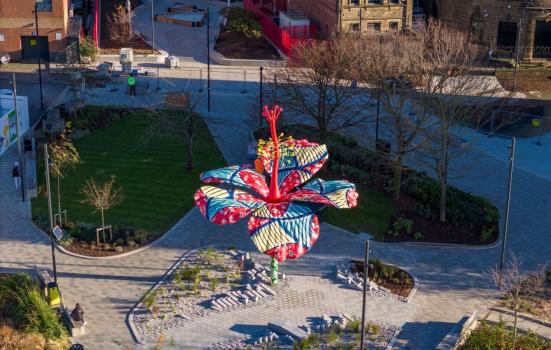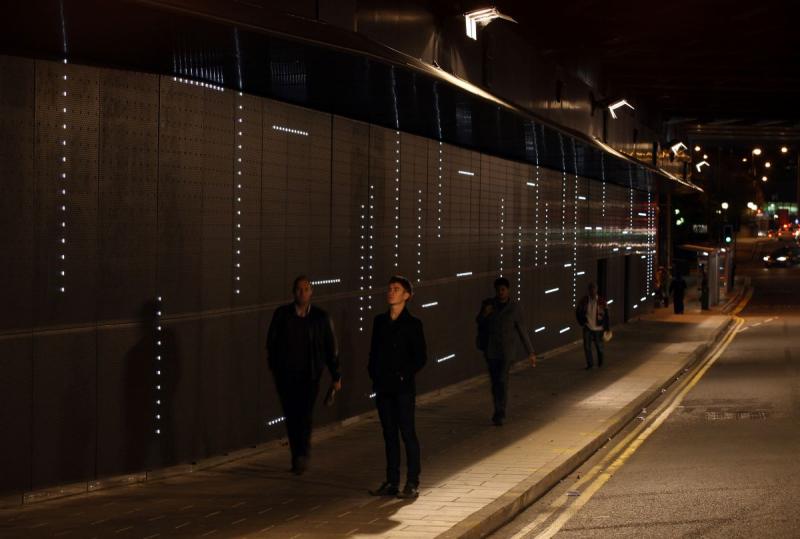In the first in our series on regeneration, Sue Ball reflects on the role of city leaders in enabling Leeds to become ‘culturally braver’ through imaginative commissioning of public art.

Octovision Media
When it comes to making great art happen in our cities and towns, cultural policy matters. But it’s not the only tool needed to deliver public art that has the power to transform places.
I’m thinking particularly of the unwavering confidence city leaders need to carry the flame for public art interventions through the twists, turns, doubters and years of delivery.
City leaders - and other enlightened clients - who value and facilitate the involvement of artists at all stages of concept development, bringing resources and people into the years-long process of creating public art projects – are rewarded with work that can have a profound impact on the cultural confidence of the whole city.
Tribute to David Oluwale
The connective tissue between one major piece of public art in a city and another isn’t always apparent but, when cultural commissioning is strategically planned, the effect on transforming places is powerful.
A case in point is the launch as part of the LEEDS 2023 celebrations, of Yinka Shonibare’s Hibiscus Rising, located on the city’s South Bank. It’s magnificent in both its form and retelling of the harrowing, lived experience and hounding to death by two white police officers of British/Nigerian citizen David Oluwale.
As this sculpture was being installed in one part of Leeds, in another the major installation A Light and Sound Transit by Hans Peter Kuhn was being decommissioned. Fifteen years apart, these artworks could not be more different - but a line can be drawn between them. Both were commissioned by Leeds City Council to connect the dynamism of the city centre with communities to the south and there is a continuity of narrative between them.
Enlightened client
A Light and Sound Transit was embedded into the infrastructure – into the very walls of ‘Light’ Neville Street which was a major regeneration corridor. The ‘enlightened client’ was the then Regional Development Agency, Yorkshire Forward (YF) which had set out an ambitious vision for its cities and towns through the Renaissance Programme.
YF’s plans amalgamated the complex entanglement of physical, transport and social infrastructure in the region and presented a case for investment that recognised the unique strengths of each city.
For practitioners like me, this strategic vision for the region enabled greater risk-taking at a city level, helped in part by the inclusion of artists on design teams, and with artist-led consultation influencing development plans.
In this project, local authorities were major partners in defining and delivering sustainable urban design and they benefitted from having greater connection with creative practitioners. There was a sense of growing confidence and enhanced knowledge from seeing ideas come to fruition.
Public art as cultural catalyst
At the time, public art was part of UK national government policy to re-balance the North-South economic divide through an investment programme called Welcome to the North.
A Light and Sound Transit was one of six iconic public sculptures, launched between 2007 and 2010, alongside Antony Gormley’s Another Place on Crosby Beach and Richard Wilson’s Turning the Place Over in Liverpool. The artworks received investment from a £100m growth initiative led by the Labour Government which recognised the potential of public art as cultural catalyst.
 'Light' Neville Street by Hans Peter Kuhn. Photo:Kippa Matthews
'Light' Neville Street by Hans Peter Kuhn. Photo:Kippa Matthews
‘Light’ Neville Street, launched in 2009, represented a significant advancement in design for a major gateway into Leeds, imaginatively drawing attention to the emerging South Bank – one of Europe’s biggest regeneration programmes.
Embedded in the specially constructed 100-metre-long thoroughfare, A Light and Sound Transit engaged audiences as a ‘non-object’ based work of contemporary public sculpture, notable for its substantial incorporation of sound as a central component.
For over a decade the interplay of light and sound transformed the gateway tunnel into an immersive urban landscape for its 19,000 daily users. Intended to be in situ for 15 years, in 2023 it was decommissioned to make way for an extensive redevelopment of Leeds railway station.
Valuable resource in scoping future regeneration projects
Now, a complete living archive of ‘Light’ Neville Street is being made available to the public thanks to a partnership with Leeds Museums and Galleries’ Archive of Sculptors’ Papers, based at the Henry Moore Institute. The archive includes documents along with anecdotes from the project team which I hope will be a valuable resource for artists, commissioners and practitioners in scoping future cultural regeneration projects.
Visitors to the archive will be rewarded by experiencing the artwork as if they are standing in the street, thanks to a specially created 360-degree video and VR headset. Later this year videos of public events will be added to the archive when the team reunite to reflect on the four years of development that lay behind the project.
The archive can also be found online on the Henry Moore Institute’s website which offers themed entry points to provide easier access into the array of project documentation.
Clear ambition for renaissance
There is no doubt that over the last fifteen years, the priorities for urban space development have changed. Good policy is important, yet we need more than that. Projects such as A Light and Sound Transit came about through a clear ambition and vision for the renaissance of Yorkshire’s towns and cities, and with this, emerged a confidence from city leaders that was amplified through the successes of high-profile risk-taking projects.
The Guardian referred to Hibiscus Rising as the city’s Angel of the North and said the Shonibare sculpture clearly demonstrated Leeds had become “culturally braver”.
I too celebrate the brave hearts of Leeds leaders and decision-makers who remain committed to such cultural interventions as vital components in connecting our communities and changing the narrative of place.
Sue Ball is Director of creative regeneration practice Media and Arts Partnership (MAAP).
Sue is leading the decommissioning programme of ‘Light' Neville Street and she was a curatorial consultant in the early phase of Hibiscus Rising.
![]() maap.org.uk
maap.org.uk
![]() @sueMAAP | @LEEDS_2023
@sueMAAP | @LEEDS_2023




